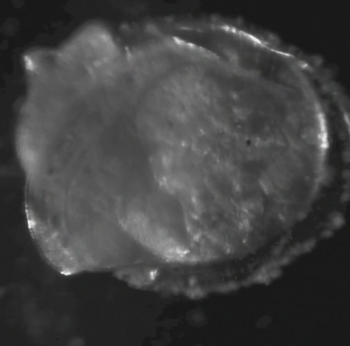ATRIA
A sound installation based on arts / science collaboration
I am currently artist in residence with the Marine Biology and Ecology Research Centre (MBERC) at the University of Plymouth where scientists are using the larvae of marine organisms to unravel the importance of key functional events during embryonic development. Research on developing hearts of the marine snail forms the basis for the ATRIA project. This is a research collaboration I have set up bringing together artists, scientists and technologists to produce an installation artwork.
Researchers in the Developmental Ecophysiology Group in MBERC (Oliver Tills, Simon Rundle and John Spicer), in collaboration with technologists from the Robotics and Intelligent Systems Laboratory (Phil Culverhouse and Julian Tilbury), have constructed an automated imaging system which enables them to put together a detailed record of the entire development of up to 400 embryos simultaneously and in real time. This is a major breakthrough. It enables them to measure key aspects of development including the timing of important functions such as the first heart beat.
The artistic project involves re-tracing the pathways of heart development and transposing scientific data into sound and image. The aim is to create a create a sensory map within which the observer is immersed. The ATRIA project focuses on three early stages of heart development identified by the scientists:
Stage 1- larval heart only present
Stage 2 – larval and adult heart present together
Stage 3 – adult heart only present
In Stage 2, for a brief period of time, the larval and adult hearts coexist before the adult heart takes over and the larval heart is re-absorbed into embryonic matter. The ATRIA installation ‘re-staged’ these developmental events through the projection of sound and image into the three atria in the Portland Square building. The aim was to set up analogies between architecture and bodies: in this installation the whole building acts as a chamber within which the heart sounds are played at a low frequency level.
The project is funded by the Faculty of Science and Technology, University of Plymouth.





